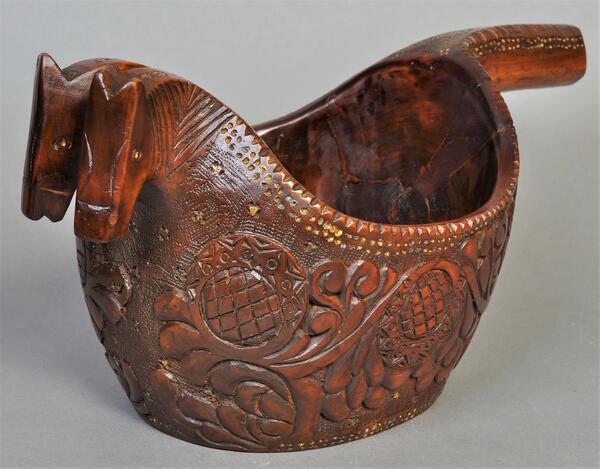In the showcase on the left, there are various items — ladles, boxes, boxes, small wooden sculptures by master Vasily Vornoskov. He was one of the leading artists of the Abramtsevo-Kudrino wood carving school.
Vornoskov was born in 1876 in the village of Kudrino, Moscow province, in a carpenter’s family. For four years he studied at the school founded by Elena Mamontova (the wife of the patron Savva Mamontov). At the age of eleven, he entered a carving workshop created by Elena Polenova, where he worked for three years.
In 1890, Vornoskov left Abramtsevo and, having established business contacts with the Sergiev Posad carpentry workshop of the Moscow province, created his own small production in his house in the village of Kudrino. Carved wooden items — boxes, ladles, chests, cabinets with polished carvings were already different from those of Abramtsevo.
Vornoskov constantly worked on improving his special style in carving: starting with geometric Abramtsevo carving, he switched to flat-relief, not with a clear outline border, but with a softly rounded ornament.
His technical innovation was the carving’s polishing, due to which the patterns seemed to be printed and the color began to shimmer from dark cherry to soft golden. Vornoskov traveled to the bazaars, looked and bought large chiseled ladles from the peasants, studied and sketched old dishes and utensils in the Crafts Museum and Historical Museum in Moscow.
In 1906, Vornoskov opened a workshop-school in his native Kudrin, where he began to teach woodcarving to peasant children with payment for their labor. Many of his students later became virtuoso carvers, among them were also his own seven sons and a daughter.
Vornoskov’s works have received many Russian and international awards. At the Handicraft Exhibition in St. Petersburg in 1902, a carved cabinet by Vornoskov received a bronze medal, in 1905 he was awarded a bronze award at an exhibition in Liege for a series of animalistic sculptures, in 1906 — a bronze medal in Chicago and a silver one in Milan. In 1908, in the Moscow Crafts Museum, with the assistance of the patron Savva Morozov, his personal exhibition was organized — the first personal exhibition of a handicrafts artist in Russia.
Vornoskov was born in 1876 in the village of Kudrino, Moscow province, in a carpenter’s family. For four years he studied at the school founded by Elena Mamontova (the wife of the patron Savva Mamontov). At the age of eleven, he entered a carving workshop created by Elena Polenova, where he worked for three years.
In 1890, Vornoskov left Abramtsevo and, having established business contacts with the Sergiev Posad carpentry workshop of the Moscow province, created his own small production in his house in the village of Kudrino. Carved wooden items — boxes, ladles, chests, cabinets with polished carvings were already different from those of Abramtsevo.
Vornoskov constantly worked on improving his special style in carving: starting with geometric Abramtsevo carving, he switched to flat-relief, not with a clear outline border, but with a softly rounded ornament.
His technical innovation was the carving’s polishing, due to which the patterns seemed to be printed and the color began to shimmer from dark cherry to soft golden. Vornoskov traveled to the bazaars, looked and bought large chiseled ladles from the peasants, studied and sketched old dishes and utensils in the Crafts Museum and Historical Museum in Moscow.
In 1906, Vornoskov opened a workshop-school in his native Kudrin, where he began to teach woodcarving to peasant children with payment for their labor. Many of his students later became virtuoso carvers, among them were also his own seven sons and a daughter.
Vornoskov’s works have received many Russian and international awards. At the Handicraft Exhibition in St. Petersburg in 1902, a carved cabinet by Vornoskov received a bronze medal, in 1905 he was awarded a bronze award at an exhibition in Liege for a series of animalistic sculptures, in 1906 — a bronze medal in Chicago and a silver one in Milan. In 1908, in the Moscow Crafts Museum, with the assistance of the patron Savva Morozov, his personal exhibition was organized — the first personal exhibition of a handicrafts artist in Russia.



